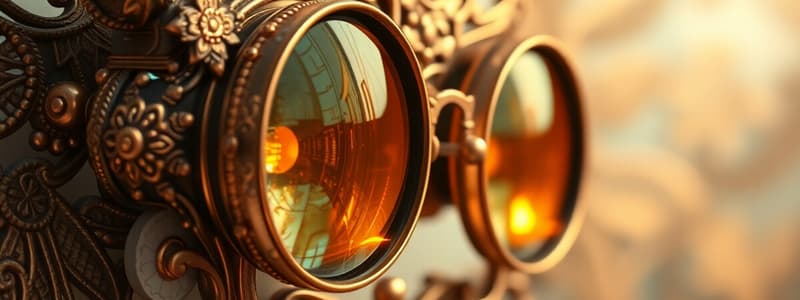Podcast
Questions and Answers
Which of the following statements about real images is true?
Which of the following statements about real images is true?
- Real images are always upright.
- Real images can only be formed by concave lenses.
- Real images are always larger than the object.
- Real images can be projected onto a screen. (correct)
What characteristic distinguishes a convex lens from a concave lens?
What characteristic distinguishes a convex lens from a concave lens?
- Convex lenses bulge outward and converge light rays. (correct)
- Concave lenses are also known as converging lenses.
- Convex lenses have a focal point that diverges light rays.
- Concave lenses can be used to create real images.
How does the focal length of a lens affect its power?
How does the focal length of a lens affect its power?
- A longer focal length indicates a more powerful lens.
- All lenses have the same focal length regardless of power.
- A shorter focal length indicates a more powerful lens. (correct)
- Focal length does not influence the power of a lens.
What is a distinguishing feature of virtual images compared to real images?
What is a distinguishing feature of virtual images compared to real images?
Which type of lens would you use to spread out light rays?
Which type of lens would you use to spread out light rays?
What best describes the way light behaves when passing through a concave lens?
What best describes the way light behaves when passing through a concave lens?
When describing the size of an image formed by a lens, the term 'smaller' specifically indicates what?
When describing the size of an image formed by a lens, the term 'smaller' specifically indicates what?
Which type of image would be formed when looking at an object in a mirror?
Which type of image would be formed when looking at an object in a mirror?
What happens to the focal point when the curvature of a lens increases?
What happens to the focal point when the curvature of a lens increases?
Which factor does NOT contribute to the power of a lens?
Which factor does NOT contribute to the power of a lens?
Which phenomenon is responsible for the apparent change in size of the Moon during its phases?
Which phenomenon is responsible for the apparent change in size of the Moon during its phases?
What orbital characteristic defines the shape of the Moon's orbit around Earth?
What orbital characteristic defines the shape of the Moon's orbit around Earth?
Which celestial body has a significant effect on the tides experienced on Earth?
Which celestial body has a significant effect on the tides experienced on Earth?
What type of celestial motion describes the Moon's rotation period in relation to its orbit around Earth?
What type of celestial motion describes the Moon's rotation period in relation to its orbit around Earth?
Which of the following best explains the characteristics of lunar maria?
Which of the following best explains the characteristics of lunar maria?
Flashcards are hidden until you start studying
Study Notes
Convex Lenses
- Shape: Bulges outward in the center
- Function: Refracts parallel light rays inward to converge at a single point called the principal focus
- Alternative Name: Converging lenses because they bring light rays together
Concave Lenses
- Shape: Caves in on both sides
- Function: Refracts parallel light rays outward, effectively dispersing them
- Principal Focus: Has a focal point, but light rays diverge
Focal Length and Lens Power
- Focal Length: Distance between the principal focus and the lens's center
- Short Focal Length: Indicates a more powerful lens, causing greater light refraction
Real Images
- Formation: Light rays converge to create an image
- Characteristics: Can be projected onto a screen (e.g., images on the retina), typically inverted
Virtual Images
- Formation: Light rays appear to converge but do not actually
- Characteristics: Can only be viewed by the eye (e.g., mirror images), upright, and cannot be projected
Image Descriptions
- Key Factors Include:
- Image type: Real or virtual
- Orientation: Upright or inverted
- Size: Bigger or smaller than the object
Real Images
- Real images can be projected onto a screen.
Lens Types
- Convex lenses are thicker in the middle, converging light rays to a focal point.
- Concave lenses are thinner in the middle, diverging light rays away from a focal point.
Focal Length and Lens Power
- Focal length is the distance between the lens and the point where light rays converge (convex) or appear to diverge (concave).
- Lens power is the ability to bend light, measured in diopters.
- Shorter focal length means a stronger lens with higher power.
- Longer focal length means a weaker lens with lower power.
Real vs. Virtual Images
- Real images are formed when light rays actually converge and can be projected onto a screen.
- Virtual images are formed when light rays appear to converge but do not, and cannot be projected onto a screen.
Lens Types and Light Behavior
- Convex lenses are used to focus light rays.
- Concave lenses are used to spread out light rays.
Image Description
- "Smaller" means the image is reduced in size compared to the object.
Mirror Images
- Mirrors always produce virtual images as they do not involve light rays converging.
Lens Curvature and Focal Point
- Increased lens curvature results in a shorter focal length, meaning a stronger lens.
Lens Power Factors
- Lens power depends on the curvature of the lens and the material it is made from.
- Thickness of the lens does not affect lens power.
Moon's Apparent Size
- The apparent size of the Moon changes during its phases due to the changing angle of observation from Earth.
Moon's Orbital Shape
- The Moon's orbit around Earth is elliptical, meaning it is not perfectly circular.
Tides
- The Moon's gravity significantly affects tides on Earth.
Lunar Rotation
- Synchronous rotation describes the Moon's rotation period synchronizing with its orbital period, causing only one side to be visible from Earth.
Lunar Maria
- Lunar maria are dark, flat plains of volcanic basalt on the Moon's surface, formed by ancient volcanic eruptions and flows.
Studying That Suits You
Use AI to generate personalized quizzes and flashcards to suit your learning preferences.




